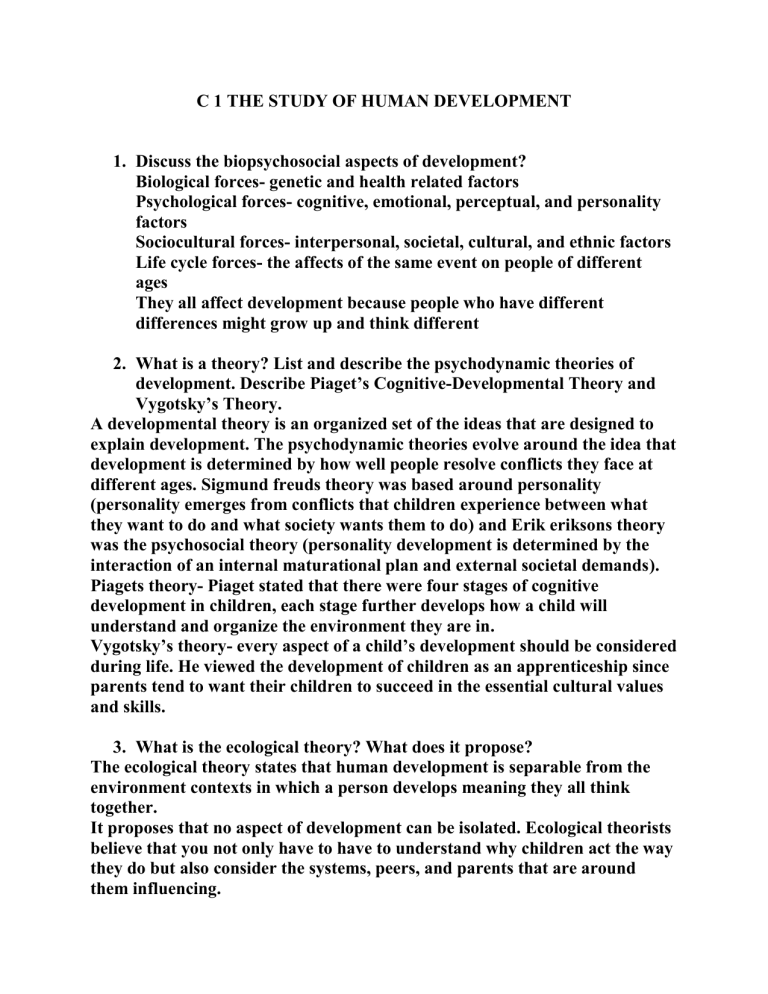
C 1 THE STUDY OF HUMAN DEVELOPMENT 1. Discuss the biopsychosocial aspects of development? Biological forces- genetic and health related factors Psychological forces- cognitive, emotional, perceptual, and personality factors Sociocultural forces- interpersonal, societal, cultural, and ethnic factors Life cycle forces- the affects of the same event on people of different ages They all affect development because people who have different differences might grow up and think different 2. What is a theory? List and describe the psychodynamic theories of development. Describe Piaget’s Cognitive-Developmental Theory and Vygotsky’s Theory. A developmental theory is an organized set of the ideas that are designed to explain development. The psychodynamic theories evolve around the idea that development is determined by how well people resolve conflicts they face at different ages. Sigmund freuds theory was based around personality (personality emerges from conflicts that children experience between what they want to do and what society wants them to do) and Erik eriksons theory was the psychosocial theory (personality development is determined by the interaction of an internal maturational plan and external societal demands). Piagets theory- Piaget stated that there were four stages of cognitive development in children, each stage further develops how a child will understand and organize the environment they are in. Vygotsky’s theory- every aspect of a child’s development should be considered during life. He viewed the development of children as an apprenticeship since parents tend to want their children to succeed in the essential cultural values and skills. 3. What is the ecological theory? What does it propose? The ecological theory states that human development is separable from the environment contexts in which a person develops meaning they all think together. It proposes that no aspect of development can be isolated. Ecological theorists believe that you not only have to have to understand why children act the way they do but also consider the systems, peers, and parents that are around them influencing. 4. What are the four features that are central to the like-span perspective? What defines successful adaptation to aging? Paul baltes and his four colleagues proposed these four features Multi directionality- development that involves both growth and decline. Meaning as people grow in one area, they may decline in another and at different rates. Plasticity- capacity is not predetermined, many skills can be learned or improved with practice Historical context- people develop within particular set of circumstances determined by the historical times in which they are born and the culture they grow into Multiple causation- development results from the biological, psychological, sociocultural, and life cycle 5. Discuss reliability and validity? Discuss representative sampling? Reliability mainly focuses on the consistency of the information being given while validity focuses on whether information is factual. Representative sampling- making sure that everything is random that way the result wouldn’t be bias. 6. What are the general designs for research? Correlations7. Contrast longitudinal studies and cross-sectional studies. The longitudinal study focuses on observing the same people across their lifespan but a cross sectional study just test different people of different ages. 8. Discuss the ethics in research. Everything that you do needs to be approved and concept from the participants. Meaning they know what your doing and sometimes what you plan to find. 9. Why are research results important? Research results are important because results are basically an outcome. Without the results a scientist or anyone wouldn’t know what the facts of a situation are. Quasi experiment- an experiment where you don’t have the reandomization that you would normally having in other experiments.



